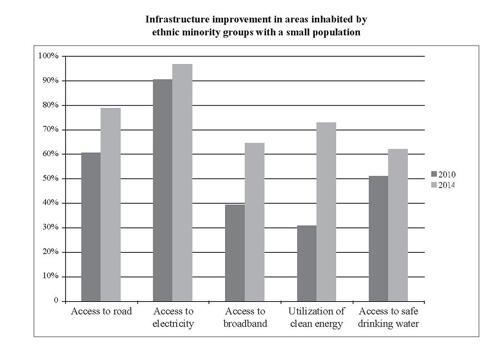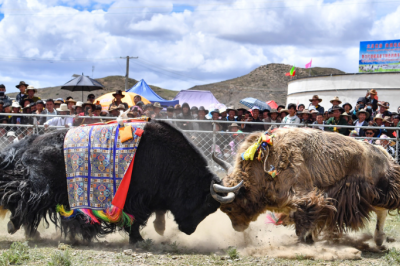|
Poverty eradication for ethnic minority groups has been accelerated. The government has developed a series of special support policies to accelerate poverty eradication for ethnic minority groups and regions inhabited by ethnic minorities. The Outline for Development-oriented Poverty Reduction for China's Rural Areas (2011-2020) maps out 14 contiguous impoverished areas, 11 of which are in ethnic autonomous areas, and 592 key counties for national development-oriented poverty alleviation work, 263 of which are in ethnic autonomous areas. Of the 30,000 poor villages mapped out in the 12th Five-Year Plan for whole-village development-oriented poverty alleviation, 13,158 are in ethnic autonomous areas. From 2012 to 2015, the central government allocated development funds of RMB14.59 billion for ethnic minority groups to advance a special campaign of developing border areas and improving local people's lives, to support development of ethnic minority groups with a small population, and to protect and develop ethnic minority villages with special features and traditional handicrafts. The central government has worked out a budget to inject RMB5.5 billion to support border areas and areas inhabited by ethnic minority groups with a small population in infrastructure construction, in improving local working and living conditions, and in developing social programs. During the 12th Five-Year Plan period, the impoverished population of the five autonomous regions (Inner Mongolia, Guangxi, Tibet, Ningxia, and Xinjiang) and the three provinces with concentrated ethnic minority groups (Guizhou, Yunnan and Qinghai) had dropped from 39.17 million in 2011 to 18.13 million, a decrease of 21.04 million, down 53.7 percent. The poverty incidence declined from 27.2 percent to 12.4 percent, down by 14.8 percentage points.
Chart: Infrastructure improvement in areas inhabited by ethnic minority groups with a small population

Oct. 17, 2016 -- Graphics shows the infrastructure improvement in areas inhabited by ethnic minority groups with a small population, Oct. 17, 2016. (Xinhua/Zhou Daqing)
IV. Improving the Development Environment of Impoverished Areas Strengthening infrastructure construction in impoverished areas to overcome obstacles to development is the basis and premise for realizing local people's rights to subsistence and development. Since 2012, the Chinese government has supported infrastructure construction in impoverished areas with more funds, further improving basic working and living conditions in those areas. Upgrading and reconstruction of communications infrastructure in impoverished areas has been accelerated. The government issued its "Broadband China" Strategy and Implementation Plan in 2013. The central government has given more financial support to communications infrastructure construction in impoverished areas, and encouraged enterprises to shoulder social responsibilities, so as to eliminate the "digital divide" in poor areas. It has worked hard to promote IT application in poor villages, grant Internet access to towns and townships and broadband access to administrative villages, spread information in the countryside, and do other work. Thus it has effectively improved communications infrastructure in poor rural areas. By the end of 2015, all administrative villages had telephone access, all towns and townships had broadband access, and the number of Internet access ports exceeded 130 million, effectively enhancing broadband penetration in impoverished areas, improving local working and living conditions, and providing strong support to industrial development in those areas. The central government has injected RMB9.22 billion, basically achieving radio and television coverage in all natural villages with a power supply and fewer than 20 households. |
- Home
- News |Tibet |Exclusive |China |World |Related News |Latest
- Documents |White Papers |Others
- Photo |Politics |Economy & Society |Culture & Religion |Human & Nature |Beautiful Tibet |Other Tibetan-Inhabited Area |Exchanges |Related
- Video |News |Documentary |Micro-Video |Entertainment
- Art
- Tourism
- In Focus
- About Tibet






